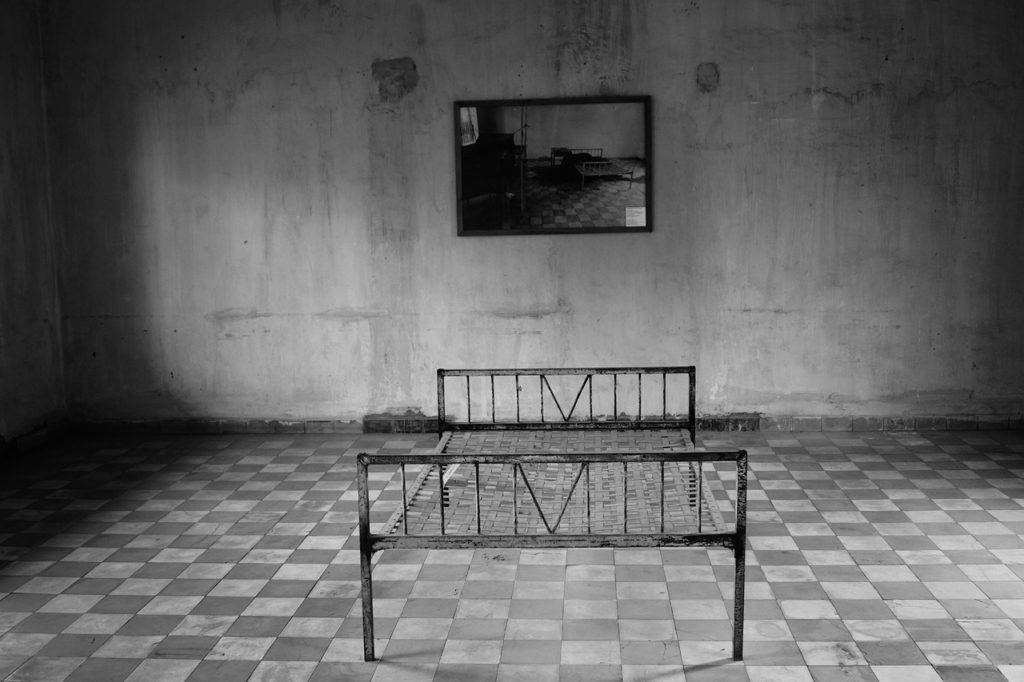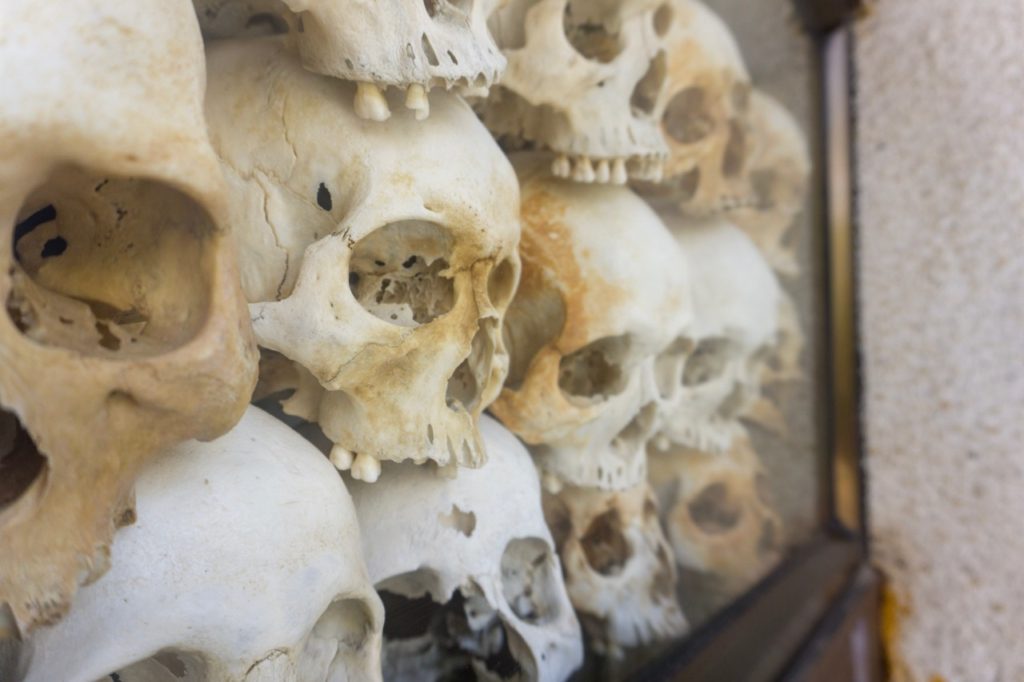It was ideology that played an important part in the Cambodian genocide. The Khmer Rouge desired to restore Cambodia to a ‘mythic past.’ They believed that the foreign aid that entered Cambodia corrupted and wanted to put an end to it by implementing Maoist ideals.
The present day capital of Cambodia is Phnom Penh. It is a country which is less than half the size of California, and is situated in Southeast Asia. After almost one hundred years of colonialist rule under France, Cambodia gained its independence in 1953. Norodom Sihanouk, the then Cambodian Prime minister had adopted neutrality as it’s official policy with the progression of the Vietnam War.
Cambodian General Lon Nol led the military coup that ousted Sihanouk in 1970. These were turbulent political times for Southeast Asia. Almost all of Cambodia were Buddhists of a population of over seven million. Cambodia is bordered by Vietnam in the east and southeast, Laos in the northeast and Thailand to the west and northwest. The Gulf of Thailand lies towards the south and southwest coastal shorelines.
The Khmer Rouge began their rule in 1975, immediately after seizing power from the Lon Nol government. Their reign of terror which was constituted as ‘genocide’ only ended when the Vietnamese overthrew them in 1978. It was the incredibly harsh climate of social and political turmoil at the time, that gave rise to the genocide. With the French decolonization of Southeast Asia taking place during the 1950s, the region continued to be devastated and developed an atmosphere of communal unrest which lasted until as late as the 1980s.

The Khmer Rouge guerrilla movement was founded in 1960 and its leader Pol Pot who had been educated in France, admired communism, more specifically ‘Mao’. He intended to create a ‘new’ Cambodia. The Khmer Rouge were tasked with taking Cambodia back to a primitive state. Every western innovation was to be removed and all citizens were to begin taking part in rural work projects that were to be set up.
The Khmer Rouge leader, Pol Pot managed to evade justice for twenty years after committing one of the worst mass murders of the twentieth century, only to then die in his sleep. About 1.7 million Cambodians died in this genocide. Pol Pot solicited Viet Cong support and built a formidable military force in Cambodia. The Khmer Rouge imposed a ruthless program of reconstructing Cambodia, according to their vision of the communist model of Mao’s China. The implementation of these extremist policies were the cause of the Cambodian genocide.
All Cambodians were made to work as laborers on collective farms by the Khmer Rouge, who wanted to build the ideal communist model. It did not matter if you were professional, educated, monks, intellectuals, Christians, Muslims, Buddhists or religious enthusiasts, all opposition were to be eliminated. This included Vietnamese, ethnic Chinese, Cambodians and Thai with Chinese, or Vietnamese or Thai ancestry.
Members of the Khmer Rouge were also interrogated and often executed because of suspicion of sabotage or treachery. Your ability to work determined your survival, which meant that those who were elderly, ill, handicapped or children, were murdered for not being able to perform the harsh physical labor that was expected every day.
Cambodia was turned into a battlefield in 1970, with a civil war that involved U.S. backed South Vietnamese and communist North Vietnamese. Cambodia quickly became a harbor for U.S. troops, barracks, weapons caches and airbases.
Although Cambodia had previously maintained a position of neutrality in the Vietnamese civil war, supporting both sides equally, U.S. troops moved into Cambodia while continuing their struggle against the Viet Cong. Over the next few years about 750,000 Cambodians died from American B-52 bombers that dropped dart cluster-bombs and napalm, in an attempt to destroy what they suspected were Viet Cong targets located in Cambodia.
Many Cambodians had become disillusioned with the western world for involving them in the war and so many lives being lost. Pol Pot’s vision gave them new hope, and a promise of national tranquility for all Cambodians. The takeover and control by Khmer Rouge military took only days.
The Khmer Rouge Killing Fields were where Cambodians were forced from their homes and villages; those who were unable to journey to labor camps were killed without a second thought. Refusal to comply and opposition of any kind, resulted in death. Entire cities were forced to move to the country. All and any rights of Cambodian citizens were abolished. Children were sent to labor camps that were separate from their parents and all institutions such as schools, hospitals, factories were immediately closed down.

Any institutions that had private owners were shut, owners were murdered and so were all their relatives and employees. Monks and missionaries were killed, churches and temples burned and religions banned. Many People were shot if they spoke in a foreign language, smiled, cried or wore glasses. Those who managed to survive, worked for endless hours for very little rations. Public communes much like military barracks, became their homes. They suffered many diseases and a constant lack of food.
Cambodians became incapable of doing constant physical labor because of the bad conditions they lived under. They were forced to contend with illness, starvation and physical injury. Anyone who became an expense to the system was killed off without hesitation. By the time Vietnam invaded Cambodia and put an end to Khmer Rouge rule in 1978 there were more than two million civilian deaths clocked up to the rule of the Khmer Rouge.
All the Great Powers of the world had opposed any attempt to stop the Khmer Rouge and bring them to justice. Pol Pot’s Khmer Rouge was supported in different ways by the Association of Southeast Asian Nations (ASEAN), the United States and China. There was not a country who would stand against the Khmer Rouge, who continued to represent their victims at the United Nations for fifteen more years. They were supported financially by many countries, a fact that has been conveniently forgotten by many.
Not only governments, but even legal bodies failed to launch investigations into the crimes committed by the Khmer Rouge, rejecting several invitations. These included Law Asia, The American Bar Association and the International Commission of Jurists. Several powerful US media houses did whatever they could to sabotage any attempt to record or draw attention to the crimes of the Khmer Rouge. In the late 1980s, the International Commission of Jurists’ Australian branch, showed an interest.
After Cambodia’s request, Experts led by the former Australian Governor-General Sir Ninian Stephen, investigated the Khmer Rouge and drew up a report recommending that an international tribunal be set up to try them for genocide, war crimes and crime against humanity in 1997. The Cambodian government have since captured and taken all surviving Khmer Rouge leadership into custody.
After Cambodia lay in ruins, the economy had failed and all professionals who had the potential to rebuild and organize the country to its former state, had been murdered. The first true democratic elections were eventually held in 1993. Buddhism was once again allowed and was then made the official state religion.
The Khmer Rouge were able to hold on to Cambodia’s U.N. seat, while being supported by China, United States and Australia, who blamed Hanoi for creating what was viewed as ‘the Cambodian problem’ instead of putting an end to the genocide. Although countries worldwide took a cold war stance against Cambodia, France decided to abstain.
International opposition to any type of legal action being directed against the Khmer Rouge was tremendous. It was only in about 1994 that this stance began to change and took on an important shift. ‘Democratic Kampuchea’ was the name the Khmer Rouge used while holding Cambodia’s seat alone. A Coalition Government was formed with two smaller non-communist parties. They were non government, non democratic and not even in Cambodia! It was until 1992 that the Khmer Rouge flag continued to fly in New York.
Thailand was the country who provided major support to the Khmer Rouge. This included physical sanctuary along the neighboring border and diplomatic aid. In 1991, General Suchinda Krapayoon of Thailand, who had seized power through a coup, described Pol Pot as a ‘nice guy’ and his deputy, Son Sen, as a ‘very good man.’ He then went further, pleading with everyone to begin treating Pol Pot fairly, as he had no intention of attempting to regain power in Cambodia.
In the 1990s, some Official Western agencies encouraged media that were Thai-based, to speculate about the Khmer Rouge leopards changing their spots. Speculation increased to report that they had become ecologists and had put out a call to all Cambodian citizens, to refrain from poaching or killing animals and birds. The Khmer Rouge were reported to now have become the protectors of endangered species. The fact that Cambodian citizens lived in fear of these leaders, probably because they felt that their lives were ‘endangered,’ was never reported in the press.
It was even reported that the Khmer Rouge would never have signed an agreement they had no intention of following, this was in regards to the Paris agreement. When the Khmer Rouge troops attacked twenty-five villages in Kompong Thom province, effectively driving ten thousand people out of their homes, certain officials continued to argue on their behalf by stating that these attacks were mounted in order to hasten the deployment of U.N. peacekeepers to that particular area.
U.S. Intelligence reported that a hundred million in weapons annually, had been provided by China to the Khmer Rouge throughout the 1980s. Although the U.S. thought of Pol Pot as an ‘abomination’ privately, their officials continued to push through international aid to the Khmer Rouge at the Thai border.
In the 1980s, The U.S. strongly opposed any effort to investigate the Khmer Rouge for genocide or any other crimes against humanity. After Thailand democratically elected a Prime Minister in 1988, the Bush administration also stood against them. Thailand engaging with Cambodia and Vietnam, was seen as almost a ‘defection’ from the stance of of U.S. and China. The U.S. Bush Administration proposed the Khmer Rouge should be included in the future government of Cambodia.
A decision in 1989, to move the Cambodian negotiations to the world forum in Paris included the Great Powers. The Paris Agreement, which allowed the Khmer Rouge to establish itself politically in Phnom Penh, was signed in 1991. A draft resolution on Cambodia, which referred to the level of genocide that had been committed during the period of Khmer Rouge rule, was considered by the U.N.’s Human Rights Commission.
It was in 1994 that the Cambodian Genocide Justice Act was passed by the U.S. Congress. Bringing justice to the perpetrators of the Cambodian genocide, had now become U.S. Policy. Yale University were funded and given the task to collect and record the facts and history of the Cambodian genocide.
No-one could have predicted that Russia, France, Britain and the United States would all be in favor of a tribunal with only China standing alone and threatening to veto it. The negotiations between Cambodia and the U.N. led to former Khmer Rouge leaders being apprehended and charged with genocide.
What seems to be most important and should never be forgotten, is the fact that an international coalition stopped the Khmer Rouge from being tried for their crimes, from 1979 to 1994. At this stage Pol Pot was still alive and the Khmer Rouge were still a threat.
Mass graves were uncovered in Cambodia in 1995, however, it proved to be difficult to bring the perpetrators to justice. In 2007 trials finally began. Currently, Cambodia appears to be peaceful, tourism is increasing but the country still suffers from the obvious detrimental effects of having a complete generation of its educated people murdered by the Khmer Rouge.
REFERENCES :
http://worldwithoutgenocide.org/genocides-and-conflicts/cambodian-genocide
http://www.historyplace.com/pointsofview/kiernan.htm
http://en.wikipedia.org/wiki/Cambodian_genocide



